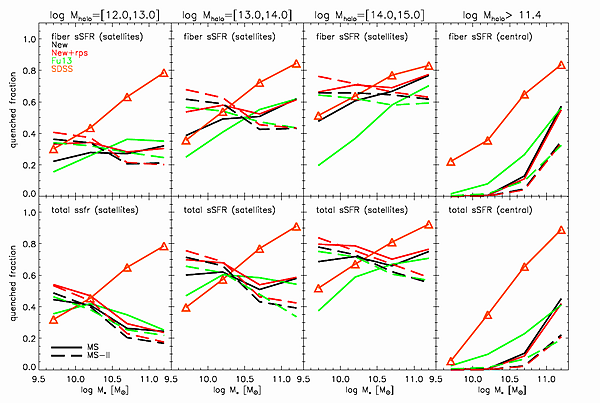Many of the observed properties of galaxies, such as their colours, morphologies, star formation rates and gas-to-star fractions, are observed to have strong dependence on their environment. Galaxies in clusters or groups tend to have redder colours, bulge-dominated morphologies, lower gas-to-star ratios and less star formation (quenching) than isolated galaxies of similar mass. This dependence is believed to arise from the interplay between the gas component of galaxies and their environment; unlike the stellar component, the gas can be easily affected by the ambient pressure in galaxy groups or clusters. In the recent semi-analytic models (SAMs) of galaxy formation, the gaseous environment of the satellite galaxy is governed by the properties of the dark matter subhalo in which it resides. This quantity depends of the resolution of the N-body simulation, leading to a divergent fraction of quenched satellites in high- and low- resolution simulations. 
By with LU Yu Figure . The quenched fraction of galaxies as a function of stellar mass: the three left-hand columns are for satellite galaxies in different halo mass bins, and the right-hand column is for central galaxies in all haloes with masses greater than 1011.4 M_. The top panels show results when quenched galaxies are defined using sSFRs measured within the SDSS fibre, and the lower panels show results when corrected total SFRs are used instead. In each panel, the triangles are the SDSS data and the coloured lines are different model predictions (solid for MS, dashed for MS-II results). In this work, Luo et al. ( The Partner group of Purple Mountain Observatory and Max Planck Institute for Astronomy ) incorporate an analytic model to trace the subhaloes below the resolution limit. They demonstrate that they then obtain better converged results between the Millennium I and II simulations, especially for the satellites in the massive haloes (log Mhalo = [14, 15]). They also include a new physical model for the ram-pressure stripping of cold gas in satellite galaxies. However, they find the problems in reproducing quenched fractions are not purely of environmental origin. Further improvements to the treatment of the gas-physical processes regulating the star formation histories of galaxies are clearly necessary to resolve these problems. This work has been published on Monthly Notice of the Royal Astronomical Society ( http://mnras.oxfordjournals.org/content/458/1/366 ). The first author is Yu Luo, co-authors are Xi Kang, Guinevere Kauffmann (MPA) and Jian Fu (SHAO). |
